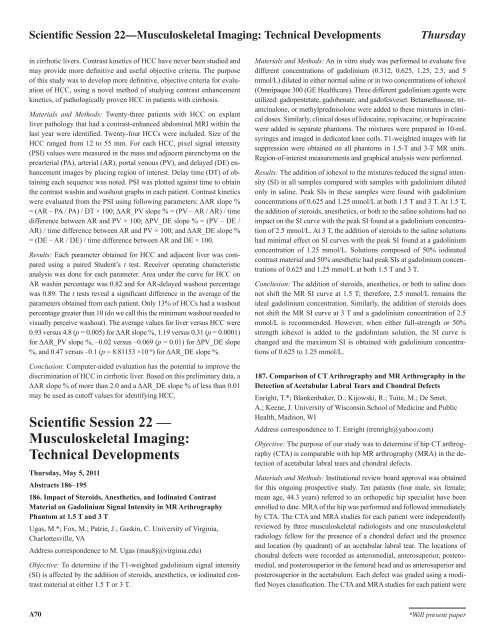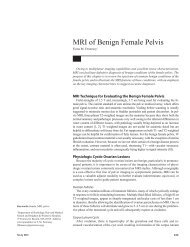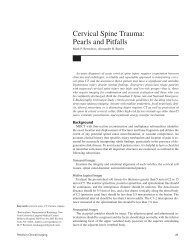Scientific Session 1 â Breast Imaging: Mammography
Scientific Session 1 â Breast Imaging: Mammography
Scientific Session 1 â Breast Imaging: Mammography
Create successful ePaper yourself
Turn your PDF publications into a flip-book with our unique Google optimized e-Paper software.
<strong>Scientific</strong> <strong>Session</strong> 22—Musculoskeletal <strong>Imaging</strong>: Technical DevelopmentsThursdayin cirrhotic livers. Contrast kinetics of HCC have never been studied andmay provide more definitive and useful objective criteria. The purposeof this study was to develop more definitive, objective criteria for evaluationof HCC, using a novel method of studying contrast enhancementkinetics, of pathologically proven HCC in patients with cirrhosis.Materials and Methods: Twenty-three patients with HCC on explantliver pathology that had a contrast-enhanced abdominal MRI within thelast year were identified. Twenty-four HCCs were included. Size of theHCC ranged from 12 to 55 mm. For each HCC, pixel signal intensity(PSI) values were measured in the mass and adjacent parenchyma on theprearterial (PA), arterial (AR), portal venous (PV), and delayed (DE) enhancementimages by placing region of interest. Delay time (DT) of obtainingeach sequence was noted. PSI was plotted against time to obtainthe contrast washin and washout graphs in each patient. Contrast kineticswere evaluated from the PSI using following parameters: ΔAR slope %= (AR – PA / PA) / DT × 100; ΔAR_PV slope % = (PV – AR / AR) / timedifference between AR and PV × 100; ΔPV_DE slope % = (PV – DE /AR) / time difference between AR and PV × 100; and ΔAR_DE slope %= (DE – AR / DE) / time difference between AR and DE × 100.Results: Each parameter obtained for HCC and adjacent liver was comparedusing a paired Student’s t test. Receiver operating characteristicanalysis was done for each parameter. Area under the curve for HCC onAR washin percentage was 0.82 and for AR-delayed washout percentagewas 0.89. The t tests reveal a significant difference in the average of theparameters obtained from each patient. Only 13% of HCCs had a washoutpercentage greater than 10 (do we call this the minimum washout needed tovisually perceive washout). The average values for liver versus HCC were0.93 versus 4.8 (p = 0.005) for ΔAR slope %, 1.19 versus 0.31 (p = 0.0001)for ΔAR_PV slope %, –0.02 versus –0.069 (p = 0.01) for ΔPV_DE slope%, and 0.47 versus –0.1 (p = 8.81153 ×10 –6 ) for ΔAR_DE slope %.Conclusion: Computer-aided evaluation has the potential to improve thediscrimination of HCC in cirrhotic liver. Based on this preliminary data, aΔAR slope % of more than 2.0 and a ΔAR_DE slope % of less than 0.01may be used as cutoff values for identifying HCC.<strong>Scientific</strong> <strong>Session</strong> 22 —Musculoskeletal <strong>Imaging</strong>:Technical DevelopmentsThursday, May 5, 2011Abstracts 186-195186. Impact of Steroids, Anesthetics, and Iodinated ContrastMaterial on Gadolinium Signal Intensity in MR ArthrographyPhantom at 1.5 T and 3 TUgas, M.*; Fox, M.; Patrie, J.; Gaskin, C. University of Virginia,Charlottesville, VAAddress correspondence to M. Ugas (mau8j@virginia.edu)Objective: To determine if the T1-weighted gadolinium signal intensity(SI) is affected by the addition of steroids, anesthetics, or iodinated contrastmaterial at either 1.5 T or 3 T.Materials and Methods: An in vitro study was performed to evaluate fivedifferent concentrations of gadolinium (0.312, 0.625, 1.25, 2.5, and 5mmol/L) diluted in either normal saline or in two concentrations of iohexol(Omnipaque 300 (GE Healthcare). Three different gadolinium agents wereutilized: gadopentetate, gadobenate, and gadofosveset. Betamethasone, triamcinalone,or methylprednisolone were added to these mixtures in clinicaldoses. Similarly, clinical doses of lidocaine, ropivacaine, or bupivacainewere added in separate phantoms. The mixtures were prepared in 10-mLsyringes and imaged in dedicated knee coils. T1-weighted images with fatsuppression were obtained on all phantoms in 1.5-T and 3-T MR units.Region-of-interest measurements and graphical analysis were performed.Results: The addition of iohexol to the mixtures reduced the signal intensity(SI) in all samples compared with samples with gadolinium dilutedonly in saline. Peak SIs in these samples were found with gadoliniumconcentrations of 0.625 and 1.25 mmol/L at both 1.5 T and 3 T. At 1.5 T,the addition of steroids, anesthetics, or both to the saline solutions had noimpact on the SI curve with the peak SI found at a gadolinium concentrationof 2.5 mmol/L. At 3 T, the addition of steroids to the saline solutionshad minimal effect on SI curves with the peak SI found at a gadoliniumconcentration of 1.25 mmol/L. Solutions composed of 50% iodinatedcontrast material and 50% anesthetic had peak SIs at gadolinium concentrationsof 0.625 and 1.25 mmol/L at both 1.5 T and 3 T.Conclusion: The addition of steroids, anesthetics, or both to saline doesnot shift the MR SI curve at 1.5 T; therefore, 2.5 mmol/L remains theideal gadolinium concentration. Similarly, the addition of steroids doesnot shift the MR SI curve at 3 T and a gadolinium concentration of 2.5mmol/L is recommended. However, when either full-strength or 50%strength iohexol is added to the gadolinium solution, the SI curve ischanged and the maximum SI is obtained with gadolinium concentrationsof 0.625 to 1.25 mmol/L.187. Comparison of CT Arthrography and MR Arthrography in theDetection of Acetabular Labral Tears and Chondral DefectsEnright, T.*; Blankenbaker, D.; Kijowski, R.; Tuite, M.; De Smet,A.; Keene, J. University of Wisconsin School of Medicine and PublicHealth, Madison, WIAddress correspondence to T. Enright (trenrigh@yahoo.com)Objective: The purpose of our study was to determine if hip CT arthrography(CTA) is comparable with hip MR arthrography (MRA) in the detectionof acetabular labral tears and chondral defects.Materials and Methods: Institutional review board approval was obtainedfor this ongoing prospective study. Ten patients (four male, six female;mean age, 44.3 years) referred to an orthopedic hip specialist have beenenrolled to date. MRA of the hip was performed and followed immediatelyby CTA. The CTA and MRA studies for each patient were independentlyreviewed by three musculoskeletal radiologists and one musculoskeletalradiology fellow for the presence of a chondral defect and the presenceand location (by quadrant) of an acetabular labral tear. The locations ofchondral defects were recorded as anteromedial, anterosuperior, posteromedial,and posterosuperior in the femoral head and as anterosuperior andposterosuperior in the acetabulum. Each defect was graded using a modifiedNoyes classification. The CTA and MRA studies for each patient wereA70*Will present paper
















